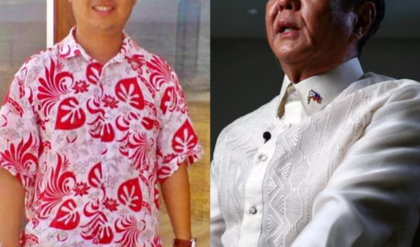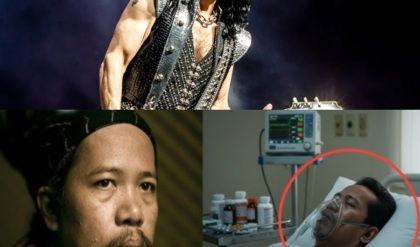Nation in Shock: The Mysterious Deleted Clip of Kim Chiu and Paulo Avelino During the Cebu Earthquake
On a seemingly ordinary day in Cebu, residents and visitors alike were caught off guard by a powerful earthquake that shook the region to its core. Buildings trembled, alarms blared, and chaos erupted in a matter of seconds. Among those caught in the terrifying tremors were two of the Philippines’ most beloved celebrities, Kim Chiu and Paulo Avelino. What should have been an event reported like any natural disaster, however, quickly spiraled into a nationwide phenomenon—not only because of the quake itself, but due to the mysterious footage that briefly surfaced online before vanishing without explanation.

The initial reports described a magnitude-strong earthquake, shaking buildings, rattling windows, and sending people rushing into the streets. Screams, the sound of falling objects, and the rumble of collapsing structures created an atmosphere of panic. Kim Chiu, known for her vibrant persona and engaging social media presence, was seen trying to maintain composure while being visibly shaken. Paulo Avelino, celebrated for his commanding screen presence and calm demeanor, appeared equally terrified as the ground moved beneath him. These raw human reactions struck a chord with viewers who could immediately relate to the universal fear evoked by such natural disasters.
What drew national attention, however, was not just the quake. Shortly after the tremor, a clip appeared online showing Kim Chiu and Paulo Avelino in the midst of the chaos. In the short segment, the camera captured their startled reactions, their hurried movements to seek safety, and the intensity of the quake’s immediate impact. But within hours, the clip had mysteriously disappeared. Viewers who had managed to watch it before deletion described the footage as “disturbing,” “rife with unexplained occurrences,” and “something out of the ordinary.” Netizens were left in disbelief, questioning what had been captured and why it was so quickly erased.
The rapid deletion of the clip fueled a wave of speculation. Social media platforms exploded with theories, ranging from simple censorship to the idea that the footage might have captured something authorities did not want the public to see. Memes, comments, and threads discussed every frame of the brief appearance online, dissecting gestures, expressions, and environmental details for hidden meaning. Some viewers suggested that objects in the background moved independently, while others hinted at shadows or figures that did not belong. While no concrete evidence has surfaced, the mysterious deletion amplified the fear and intrigue surrounding the event.

Kim Chiu’s and Paulo Avelino’s presence during the quake added a layer of celebrity fascination to an already tense situation. In the Philippines, both actors have amassed enormous followings, with fans closely monitoring their social media updates and television appearances. Their reactions, captured in real-time, made the event more personal and relatable for the audience. For many, seeing beloved celebrities experience fear firsthand made the dangers of the earthquake more tangible. However, the sudden disappearance of the clip also introduced an element of distrust, prompting viewers to question whether the public was being denied access to critical information.
Authorities and media outlets remained largely silent in the immediate aftermath. While reports of the earthquake’s magnitude and damage circulated, no official explanation was provided for the deleted clip. This silence only intensified speculation. Commentators debated whether the footage had been intentionally removed due to sensitive content, safety concerns, or to avoid public panic. Some suggested that the deletion might have involved potential structural damage or safety violations that authorities preferred not to publicize. Others argued that the video could have captured a phenomenon beyond simple physical destruction, adding an eerie dimension to the incident.
The social media response was unprecedented. Within hours of the clip’s disappearance, hashtags referencing the footage began trending nationwide. #CebuEarthquakeMystery, #KimChiuPauloClip, and #DeletedFootage became central to discussions on Twitter, Facebook, and TikTok. Viewers shared screenshots, short replays, and eyewitness accounts, creating an almost collaborative attempt to reconstruct the missing footage. Comment sections overflowed with speculation, fear, and curiosity, while vloggers and influencers offered their own analyses, often blending factual reports with conjecture about the “erased” elements in the clip.
Eyewitness testimonies further deepened the intrigue. Residents near the quake’s epicenter reported unusual occurrences during the tremor, describing objects moving in unexpected ways, sudden flickering of lights, and strange shadows. Although many accounts could be attributed to natural chaos during an earthquake, others claimed that the deleted clip had captured subtle anomalies, too fleeting to be easily verified but striking enough to provoke discussion online. The combination of celebrity presence and these alleged anomalies created a cultural moment unlike any other in recent Philippine history.
The disappearance of the clip also raised ethical and legal questions about media coverage and censorship. Should footage of disasters be fully transparent, or are there circumstances where deletion is justified? Critics argued that withholding visual evidence, particularly in an event affecting public safety, erodes trust between citizens and authorities. Others emphasized the sensitivity of celebrity images, noting that Kim Chiu and Paulo Avelino’s involvement might have warranted editing or removal to protect privacy. The tension between public interest and personal or institutional concerns fueled an ongoing debate that continues to capture attention.
Cultural analysts noted the psychological impact of the incident. The deleted clip became a symbol of uncertainty, fear, and curiosity. In an age dominated by social media, where information is rapidly shared and equally quickly removed, audiences became participants in the mystery itself. The clip’s erasure triggered a collective imagination, leading netizens to fill in the gaps with theories and scenarios, blurring the lines between reality and speculation. This response reflects broader societal anxieties about information control, transparency, and the limits of what the public is allowed to see.
Meanwhile, Kim Chiu and Paulo Avelino issued statements on their social media accounts, emphasizing their safety and urging fans to remain calm. Both expressed gratitude for concern but refrained from commenting on the mysterious deletion of the clip. Their measured response helped stabilize some public fears while simultaneously reinforcing curiosity about the contents of the missing footage. Fans respected their restraint, while critics continued pressing for transparency, highlighting the complex dynamics between celebrity image, media management, and public expectation.
The incident also offers insight into the role of celebrity in shaping disaster narratives. In many countries, famous figures help humanize events, drawing attention to crises and fostering empathy. Kim Chiu and Paulo Avelino’s reactions provided a human lens for audiences, making the earthquake’s impact relatable. At the same time, the deleted clip introduced an element of narrative control, reminding viewers that media coverage is rarely neutral and often mediated by considerations beyond immediate reportage. The public’s reaction to both the footage and its removal demonstrates the heightened expectations for accountability in the digital age.
Experts on natural disasters noted that the Cebu earthquake itself, regardless of the deleted clip, was significant. It caused widespread tremors, minor structural damage, and temporary disruption to local infrastructure. Emergency services were activated promptly, with authorities ensuring that evacuation and rescue procedures were followed. Nevertheless, the clip’s brief existence and subsequent erasure overshadowed these logistical responses, illustrating how viral content can dominate public perception even amid a real-world emergency.
From a broader perspective, the Cebu earthquake incident, combined with the deleted footage, reflects contemporary challenges in media consumption. Audiences are simultaneously informed, entertained, and unsettled by digital content. The rapid dissemination and removal of footage create an environment where speculation thrives. The public’s fascination with mystery, celebrity involvement, and unexplained occurrences converged to amplify the story’s reach and impact. This convergence of natural disaster, celebrity, and media manipulation created a perfect storm for nationwide engagement.
Legal and ethical implications also remain central to the discussion. While no official claim has been made about wrongdoing in the deletion of the clip, questions about media responsibility, access to information, and transparency persist. Should authorities release all footage of natural disasters, or can some content be withheld for safety, privacy, or public order? The Cebu incident underscores the delicate balance between transparency and discretion, illustrating the competing priorities faced by both media organizations and government institutions.
Meanwhile, cultural commentators observed that the deleted clip functioned as more than a piece of missing footage—it became a cultural artifact of digital age anxiety. It highlighted the interplay between fear, curiosity, and the power of social media to shape perception. The mystery itself became a form of storytelling, with viewers crafting their own narratives around what might have occurred in the fleeting seconds of footage. This participatory element demonstrates how modern audiences engage with media in ways that extend beyond passive consumption.
Ultimately, the incident left Filipinos with more questions than answers. What did the cameras capture that prompted immediate deletion? Was the footage erased to protect Kim Chiu and Paulo Avelino, to prevent public panic, or to conceal something unexplained? While official answers remain absent, the event has already imprinted itself on the national consciousness, sparking debates about transparency, media ethics, and the role of celebrities in public crises.
In conclusion, the Cebu earthquake and the mysterious deleted clip featuring Kim Chiu and Paulo Avelino represent a convergence of natural disaster, celebrity culture, and digital-age intrigue. The earthquake itself was a significant event, but the brief, vanished footage transformed it into a national phenomenon. Social media amplified the story, driving speculation, fear, and fascination across the Philippines. The reactions of the celebrities, the silence of authorities, and the engagement of netizens all contributed to a cultural moment defined by curiosity, uncertainty, and the power of modern media.
As Filipinos continue to discuss, speculate, and analyze the incident, one lesson is clear: in the digital age, even the shortest clip can ignite nationwide discourse, shape public perception, and create lasting cultural impact. The mystery of the deleted Cebu earthquake footage will likely remain a topic of debate for months, if not years, a reminder of the intersection between human vulnerability, celebrity influence, and the power of media to captivate, shock, and provoke thought.





